
The possibility of using membranes to separate peptides from a chicken byproduct hydrolysate and the effect of the performed downstream processing on the DPP-IV dipeptidyl peptidase IV inhibitory activity of mechanical deboning chicken residue has been investigated.
Membrane processes, such as microfiltration, ultrafiltration, and nanofiltration, are increasingly used for various applications in both upstream and downstream processing. Membrane-based processes play a critical role in the field of separation/purification of biotechnological products, including protein production/purification. The possibility of using membranes to separate peptides from a chicken byproduct hydrolysate and the effect of the performed downstream processing on the DPP-IV dipeptidyl peptidase IV (DPP-IV) inhibitory activity of mechanical deboning chicken residue (MDCR) has been investigated. The chicken byproduct hydrolysate was prepared by enzymatic hydrolysis followed by microfiltration (MF), ultrafiltration (UF), nanofiltration (NF), and reverse osmosis (RO) separation. Comparing all separation treatments, hydrolysates processed only by MF and UF show the best DPP-IV inhibition (59.5–60.0% at 1 mg/mL and 34.2–40.7% at 0.5 mg/mL). These samples show dose-responsive behavior. Bioactivity was correlated with molecular weight distribution profiles and average molecular weights. The nanofiltration process notably decrease the inhibitory activity, and these permeates show low DPP-IV inhibition (9.5–21.8% at 1 mg/mL and 3.6–12.1% at 0.5 mg/mL). The size-exclusion chromatography–organic carbon detection–organic nitrogen detection (LC–OCD–OND) analysis confirms that NF and RO would retain the bioactive peptides in the concentrate in comparison to MF and UF. Bioactivity was correlated with molecular weight distribution profiles and average molecular weights. Permeates after ultrafiltration show an IC50 value of 0.75 mg/mL, comparable to other potent DPP-IV inhibitors derived from various food sources, and significantly more potent compared to the microfiltration sample, which shows an IC50 value of 1.04 mg/mL. The average molecular weight of the permeates calculated from the SEC chromatograms was 883 g/mol for UF and 1437 g/mol for MF. Of the four membranes studied, the UF membrane shows the best separation properties with respect to maximizing the yield and up-concentration of the bioactive peptides. Overall, UF was demonstrated to be a feasible technology for the removal of the undesired high-molecular-weight substances and up-concentration of small-molecular-weight bioactive peptides from chicken byproduct hydrolysate. These peptides might exhibit biological activity and could offer several health benefits. There is a high potential for the use of bioactive peptides, and more research in this field can lead to promising results that have significant effects in the food and medical industries.
Read the full publication: Dibdiakova, J.; Matic, J.; Wubshet, S.G.; Uhl, W.; Manamperuma, L.D.; Rusten, B.; Vik, E.A. Membrane Separation of Chicken Byproduct Hydrolysate for Up-Concentration of Bioactive Peptides, Membranes 2024, 14, 28.
Membranes | Free Full-Text | Membrane Separation of Chicken Byproduct Hydrolysate for Up-Concentration of Bioactive Peptides (mdpi.com)